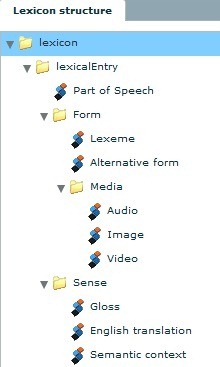LEXUS is a web-based lexicon tool developed by the The Language Archive at the Max Planck Institute for Psycholinguistics, Nijmegen, The Netherlands (MPI). It is targeted at linguists doing language documentation or working with language corpora.
In LEXUS users may create lexica in online (private) workspaces and share lexica with other users either on a read-only basis or by assigning edit rights. Since LEXUS is web-based this sharing functionality allows a group of users to collaboratively create a lexicon from different places in the world, or to share lexica amongst linguistic researchers and speech community members.
LEXUS allows you to create lexica or import them from other formats (such as Toolbox). LEXUS is not just another lexicon tool: LEXUS offers the possibility to visualize language through the import of multimedia. There are various types of multimedia that can be linked to the lexical entries (i.e. images, video/audio files and webpages). For the DoBeS projects, MPI research and for research from third parties, data is stored in the digital archive for linguistic resources housed at the MPI. The archive is accessible via the Internet, and is organized in a structured manner by describing and contextualizing the data with the IMDI/CMDI metadata set. Lexical entries in LEXUS can be linked to domains and resources from this archive.
Lexicography in general is a domain in which uniformity and interoperability is rarely met. Depending on the purpose and tools used, various terminologies, structures and formats have been adopted. This makes cross lexica search, merging, linking and comparison extremely difficult. The Lexical Markup Framework (LMF) is an attempt at putting an end to this problem. LMF is an abstract model for the creation of customized lexica that are defined following the recommendations of the ISO/TC 37/SC 4 group on the standardization of linguistic terminology. LEXUS allows you to create purpose-specific and tailor-made lexica encouraging at same time the LMF-based comparability and interoperability with other resources. More information on Lexical Markup Framework can be obtained from the LMF web site.
For new lexica, the structure of a LEXUS lexicon is predefined according to a template chosen by the user when the lexicon is created. The default and most basic template follows the schema given in Figure 1.1:
Each of the elements in the schema can be expanded according to the wishes of the creator. Basically there are two ways of elaborating on such a model. You can add both a data container (which has the function of a folder) and a data category (which is a sheet to store relevant linguistic information). The lexicon structure is a hierarchy, in which data categories are placed inside data containers. The former ones are used in order to group elements that have something in common.
Form and Sense are the two most basic data containers. A number of other more specific data containers can be underpinned to them, which, in turn, can include other sub-containers. The goal is to store the data categories under the data containers as it is the data categories that encompass the lexical information of an entry. It is up to the user to define the structure of the lexicon and in principle there are no restrictions to it. In Figure 1.2 we show a simple example of such a structure.
Together with LEXUS comes ViCoS - a tool for visualizing conceptual spaces. With ViCoS you may extend your lexicon with a set of relations between lexical entries or between specific data category labels within the lexical entries. ViCoS thus allows the creation of a semantic network and the navigation through this network. Since ViCoS also allows the creation of user/lexicon-specific types of relations, the network, which in this way is created, goes beyond the semantic level onto the cultural one given that conceptual spaces show words/attributes within the cultural context. For more information on ViCoS see either the Chapter 7 or the TLA webpage .
For the best functioning of LEXUS and ViCoS, we recommend to use the newest version of the Mozilla Firefox browser (with a minimum screen resolution of 1280 x 1024) and the latest Flash Player plug in.
Watch the video:
